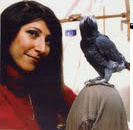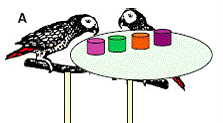Contents

Time heals. Not, however, neither nearly as quickly nor as fully as we are led to believe. Five years after Alex’s passing, he is still sorely missed; by me and, I believe, by Griffin and Arthur, the other African grey parrots in my lab. Days still exist, particularly when I return after a long absence, during which I walk into the laboratory, glance at the cage in the far corner of the room, and expect to be greeted by Alex’s familiar, imperious “Come here!” [Yes, we still have Alex’s cage; Griffin likes to climb on it and play there. We think it helps him accept Alex’s absence and gives him some confidence in his new role as “alpha” bird.] Alex’s voice, of course, has been stilled, and the momentary sadness passes, because Griffin’s more plaintiff “Come here” and Arthur’s “Tickle” make it clear that life and research in the lab continues.
And research most certainly does continue. Both birds have participated in studies on reciprocal behavior and on reasoning by exclusion, and Griffin has just finished work showing that he sees some common optical illusions just as humans do. I’ll describe the first two experiments, as they have either been published or have been accepted for publication.
Give Or Take?
The reciprocity study, begun under the direction of a visiting French colleague, Franck Péron, was designed to see if the birds would work together on a task in order to maximize their rewards. The task was as follows: Each bird could, in turn, choose one of four colored cups on a tray in the presence of the other bird. The choice of each cup had a different consequence, and the human trainers disbursed the rewards: Choose pink, and you get a treat; choose orange and your partner gets a treat; choose purple and no one gets anything; choose green and you both get treats.
 Clearly, if the birds figured out the system, they’d realize that if they cooperated and each chose green, they’d be rewarded all the time. We also added a little twist: We let Griffin, the dominant bird, choose first on half the trials, and let Arthur choose first on the other half to see if that made a difference. We ran the experiment for a long time — 500 choices for each bird — to see if their behavior might change over time and if they would learn to work together. The results were quite interesting.
Clearly, if the birds figured out the system, they’d realize that if they cooperated and each chose green, they’d be rewarded all the time. We also added a little twist: We let Griffin, the dominant bird, choose first on half the trials, and let Arthur choose first on the other half to see if that made a difference. We ran the experiment for a long time — 500 choices for each bird — to see if their behavior might change over time and if they would learn to work together. The results were quite interesting.
At the beginning of the sessions, Arthur, whether he began trials or not, tended to choose orange, thereby giving the dominant Griffin the reward — or he chose purple, as though he didn’t want to give up the reward but was afraid to take something for himself. Griffin, the dominant grey, chose green on a lot of early trials, both as leader and follower, maybe trying to show what to do to get the most rewards. We weren’t too surprised. But then, over time, things changed!
Arthur realized that humans were disbursing the treats, and Griffin couldn’t “punish” him in any way. So Arthur became more and more selfish. Griffin reacted to Arthur’s behavior by becoming completely selfish, but only when he was in the leading position. When Griffin was in the (very unaccustomed!) situation of having to go second, he continued to choose green — to share — at about the same rate as in the first trials, though he also acted a bit more selfish than at the start. It seemed that Griffin, when forced to be subordinate, was either trying to show Arthur that he could be nice or to continue to demonstrate what “should” be done, maybe in order to regain that dominant position!
Follow The Treat
The reasoning-by-exclusion study was begun to see if parrots could figure out where a treat would be after they were given a clue as to where it was not. The task sounds confusing, but it has been used to show that nonhuman primates can think the same way as humans do, and we wanted to see if parrots would respond similarly.
David Premack, a psychologist studying chimpanzees, designed the following task. He showed his apes that he was hiding an apple under one container and a banana under another. Then, in the absence of the apes, he removed one of the fruits (the “invisible” condition). He let the apes see him eat the apple and then let them search the containers. If they remembered where each fruit had been hidden, and realized that the apple would no longer be present, they would know to search for the banana under the correct container.
Of course, all sorts of controls needed to be in place so that the animals were not inadvertently cued, for example, by the scent of the fruit. Moreover, they had to have liked both fruits equally well, so they wouldn’t go only to the place where they thought a favorite treat might be hidden. The task can, theoretically, be made simpler by showing the nonhuman what is being removed and where the removal is occurring (the “visible” condition), but such a procedure actually confuses some animals: They are distracted and choose the container that the experimenter has touched, possibly assuming that the experimenter is cluing them to go to that container. Arthur and Griffin, as well as two pet African grey parrots of former trainers in our lab, Carl and Leigh Ann Hartsfield, however, were not confused and succeeded under both the visible and invisible removal conditions.
Interestingly, while we were in the middle of our study, our Austrian colleagues published a paper showing that at least one of their African grey parrots could do the invisible task —“scooping us”— but we had some additional twists to our protocol. We wanted to make sure that the birds really understood what was under each cup and that they were not simply avoiding the cup from which something had been taken. We specifically wanted to see if they knew when to reason by exclusion and when not to do so. So, in the next experiment, we hid two pieces of food under each cup, but one cup had special treats and the other had their regular pellets.
We removed either one treat or one pellet, and mixed these trials with the original trials with just one piece of food initially under each cup. If the birds were paying attention, they should be able to distinguish the two sets of intermixed trials. In the “two rewards under each cup trials,” they should always choose their favored treat; after all, even one treat should be preferred to two pellets. Similarly, in the “one reward under each cup” trials, they should continue to reason by exclusion. Griffin, Arthur and one of the Hartsfield’s birds succeeded, showing that African grey parrots were at least as intelligent as apes and young children!
Clearly, lots of work remains to be done before we fully understand the intelligence of these remarkable creatures. Even after more than 30 years of study, and even with the loss of our star pupil Alex, we are continuing to figure out just how smart African grey parrots really are.
Dr. Irene Pepperberg is an adjunct associate professor at the Dept. of Psychology, Brandeis University, Waltham, MA. She is also a lecturer and research associate at Harvard University, in Cambridge, MA.
You can help Dr. Pepperberg continue the groundbreaking parrot research she began more than 30 years with Alex, the African grey parrot that won admirers from around the world with his cognitive abilities. If you shop online through sites such as Amazon.com, you can designate the Alex Foundation to receive a percentage of your final sales, or register with the Alex Foundation at iGive.com and a percentage of sales from companies associated with iGive will go to the foundation. The Alex Foundation also has a “Donate” button linked to PayPal. Visit http://alexfoundation.org and click on the “Support Us” link for more information.
Sterner Matching Challenge: From now until January 5th, 2013, Andy Sterner will generously match all donations made to the The Alex Foundation up to a total of $10,000! If you’ve ever thought about giving to The Alex Foundation now is a great time by doubling your donation! All you have to do to qualify is give. No need to specify anything when you make your payment. Click here.






Great article keep up the great work Dr. Pepperburg, you go Griffin and Authur.
How incredibly intelligent these remarkable creatures are! Thank you so much for sharing this story of your continuing work with us. Alex is in perfect feather, flying there amoung the clouds with Angel wings. We will miss him and part of him will always be with you.
I have followed Irene Pepperberg and Alex for years and was also saddened when he died. I enjoyed reading this article and knowing that this research is stilll going on. I am glad that Griffin and Arthur are doing well.
a credit to the love of birds
What is wrong with me!!! I have had my DVD for months and I am still afraid to watch it..I am crying just reading the 1st 2 paragraphs of this post from you. I know you still cry, too, but I never got to meet or touch him..you spent everyday with him. I also know I am not the only person he impacted this way…Huge soul on that wonderful “person.” One of God’s amazingly special creations.
Sorry..maybe I’ll recover eventually.
My gray, Toby can say “Come here!” as well – but it’s not like having Alex here.
Much Love,
JW
I was so saddened by Alex’s passing five years ago, and was fearful that research on parrot intelligence, behavior, etc., would come to a halt. I’m happy to see that work continues to be done revealing how incredibly wonderful birds truly are!
I play reasoning by exclusion games with my Illiger’s macaw every day. Of course, our play doesn’t have scientific controls. Foggy is very persistent, and finds all his treats nearly every day. Parrots are amazingly smart!! They only needed Dr. Pepperberg in their corner to prove it.
Great article and incredibly intersting experimets.
Keep up the good job Irene.
thank you for keeping us posted. My African Grey never ceases to amaze me. I really think the little girl is a human trapped happily in a bird’s body! lol. 🙂
Keep it up!
The actual dictionary definition of intelligence is
The ability to solve problems based on survival
in other words
Anything that survives is by definition . . . . “intelligent”
we are all sentient beings . . . . . ..some having a bird existence
some having a cat existence
some having a dog/human existence
all these experiments just prove. . . . how stupid WE are !
I have not read the book as life has handed me so beloved
pets that has left us also. Dr P you have always had my profound
respect. When Hurricane Sandy hit my hometown was washed
away. My husband and I have sent three big boxes of Aloha
to the first responders. After the new year we will donate to
your foundation. We wish you and your staff a
Mele Kalikimaka and a very
Blessed New Year
Ellie and Nick George Grammas Aviary were Greys Rule